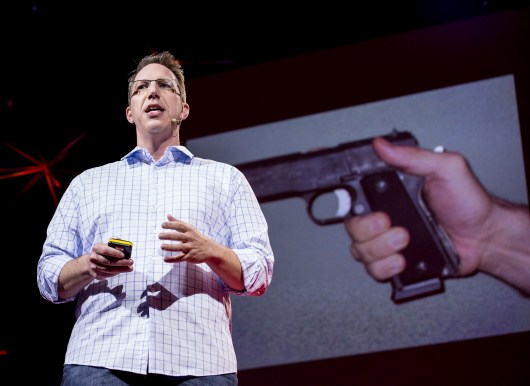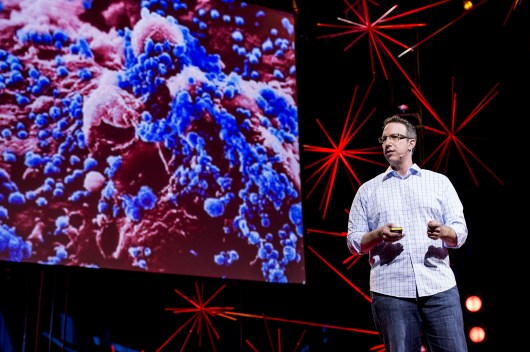Everyone can use technology. Everyone.
Marc Goodman starts, cheerily, by saying, “I study the future of crime and terrorism. And quite frankly I’m afraid.” He want to believe that technology will be the utopia, as many hope. But he’s spent his life in law enforcement around the world, and that has given him a perspective that includes many bad things along with the good. He’s here to show us the other side of all the technologies that are transforming the world for the better.
Criminals have, of course, always used technology. Early on, criminals used pagers and mobile phones — in fact, the local drug dealers had pagers long before he or any police officer he knew had one. Now the criminals are building their own mobile networks. In Mexico, drug cartels have constructed a cell network that spans all 31 states. Think about that infrastructure, says Goodman, and then think, “Why can’t I get a cell signal in San Francisco. We consistently underestimate what criminals and terrorists can do.”
In an open world, people can use information for good or for evil.
Goodman asks us to consider the 2008 terrorist attack in Mumbai. The terrorists had AK47s, just like many had had for years, but they also had infrared goggles, phones and satellite imagery. But the scariest, and newest, part was that they had a fully equipped war room across the border in Pakistan where they monitored the BBC, social media and more. They used that information “to great effect.” As a terrifying example, the terrorists broke into a suite in the Taj Hotel, where they found a cowering man who claimed to be a poor schoolteacher. They phoned in his ID to the war room, where they Googled him — and found that he was in reality the second-wealthiest businessman in India. The war room gave their order: “Kill him.”
“We worry about our privacy settings on Facebook, but our openness can be used against us,” says Goodman. Witnesses reported that the terrorists were holding guns in one hand and checking mobile messages in the other. In this siege, 10 men armed with guns and technology were able to bring the whole city to a standstill. “This,” says Goodman, “is what radicals can do with openness.”
There has also been a paradigm shift in crime. In the last couple hundred years, we’ve gone from one person robbing another to train robberies, where one gang could rob 200 people at a time. Now, that’s scaled to the Sony PlayStation hack, which affected 100 million people. “When in history was it ever possible for one person to rob 100 million?”
The scary side of technology
Goodman shows a video of Vijay Kumar’s quadcoptors, world-premiered in his TEDTalk just a few months ago. It’s a cute scene of autonomous flying robots playing the James Bond theme. But the scene shifts to a video of those same robots loaded with firearms, destroying targets.
What about the 3D printer? Those are the future of manufacturing. He shows us a cute rubber duck he printed. Of course, they can also be used to create other things, as he shows us. “If you can print in metal, you can print one of these.” And he holds up a 3D-printed gun. And a printable silencer.
And the internet? The world, of course, is becoming incredibly connected, but more connections means more vulnerabilities. “There has not been an operating system that has not been hacked,” says Goodman, who is worried now about the human body. What if hackers target pacemakers or other implanted devices?
Or, what about synthetic biology? Could hackers do something with DNA, “the original operating system”? Goodman imagines a plant-based narcotics world. Cut-and-pase a gene into yeast, and produce, say, cocaine bread and beer.
But it gets even scarier. If you can target an individual cancer cell with a revolutionary treatment, that means you can target an individual genome — maybe from one of these people: Cue the photo of our current world leaders. As he puts it, “Personalized bioweapons are the flipside of personalized cancer treatments.”
What can we do?
It’s clearly not simple. Goodman shows us a photo of a backed-up airport line caused by the US government’s response to 9/11, the TSA. And as Goodman says, “if you expect the people who designed this to protect you from the coming robo-apocalypse, you might want to have a backup plan.”
Goodman has one idea. What about using the same openness that the future terrorist will use against us, against them? Rather than the TSA model, what if we opened up security? There are already projects to crowdmap drug cartels, and we could do much more. “The tools to change the world are in everybody’s hands,” says Goodman, “and how we use them is not just up to me. It’s up to all of us.”
He finishes by showing us a police line and inviting us to cross it — because “Public safety is too important to leave to the professionals.”
Watch Goodman’s previous TEDx talks from TEDxLosGatos >> and TEDxGotham >>.
Photos: James Duncan Davidson


Comments (4)
Pingback: MOST OF THE WEB IS INVISIBLE TO GOOGLE. HERE’S WHAT IT CONTAINS | CoinGreed.com
Pingback: The Future of Crime: How Technology Will Force Us to Stay One Step Ahead of the Smarter Criminal | artsyanalytic
Pingback: lennyesq
Pingback: Jeux vidéos, consommation collaborative et menaces terroristes | TEDGlobal Edimbourg 2012